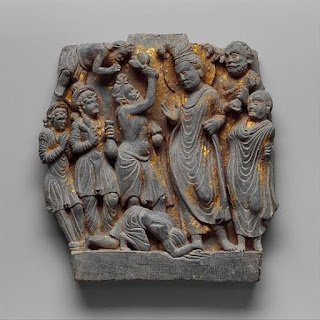( Gandhara Sculpture)
( Buddha in Gandhara sculpture )
( Gandhara sculpture)
( Buddha meets a Brahmin )
( A Gandhara Bodhisattva)
( A Gandhara Buddha in Metropolitan Museum of Art New York. Greek influence is starkly visible)
( A Gandhara Bodhisattva )
( A Kushana King . Gandhara sculpture)
( Buddha in Gandhara sculpture )
( Gandhara sculpture)
( Buddha meets a Brahmin )
( A Gandhara Bodhisattva)
( A Gandhara Buddha in Metropolitan Museum of Art New York. Greek influence is starkly visible)
( A Gandhara Bodhisattva )
( A Kushana King . Gandhara sculpture)
BODHISATTVAS WITH MOUSTACHES..
I have seen many Gandhara sculptures in museums wherein Bodhisattvas are shown with moustaches making them look like normal human beings .Many ancient Greek ,Roman and Bactrian sculptures have also beards and moustaches .
The Gandhara School of art developed in first century AD along with Mathura School during reign of Kushana emperor Kanishka. The Kushanas were patrons of Gandhara School.Possibly Kushanas were first to sculpt the Buddha in human form.The Gandhara region had long been at crossroads of cultural influences of East and West.
Between the first and fifth centuries of our time, Gandhara art flourished in the area that is northwest Pakistan today.
Well-known cities of the Gandhara include Takshasila (Taxila), Purushapura (Peshawar) and Pushkalavati (Mardan), where remains have been discovered and continue to be found to this day.
Gandhara witnessed the rule of several major powers of antiquity .It was ruled by Persian Achaemenid Empire (c. 600-400 BCE), Greeks of Macedon (c. 326-324 BCE), Mauryas of Northern India (c. 324-185 BCE), Indo-Greeks of Bactria (c. 250-190 BCE), Scythians of Eastern Europe (c. 2nd century to 1st century BCE),Parthian Empire (c. 1st century BCE to 1st century CE), Kushans of Central Asia (c. 1st to 5th century CE), White Huns of Central Asia (c. 5th century CE), Hindu Shahi of Northern India (c. 9th to 10th century CE). This was followed by Muslim conquests by which time we come to the medieval period of Indian history.
I believe that the Gandhara sculptures are also highly influenced by Greek and Bactrian style. The moustaches could be Greco-Bactrian influence. Any other opinion is welcome.
( Avtar Mota)
CHINAR SHADE by Autarmota is licensed under a Creative Commons Attribution-Noncommercial-No Derivative Works 2.5 India License.
Based on a work at http:\\autarmota.blogspot.com\.








No comments:
Post a Comment
Note: Only a member of this blog may post a comment.